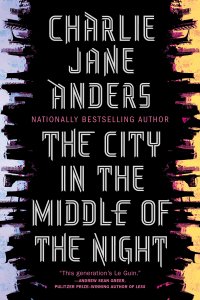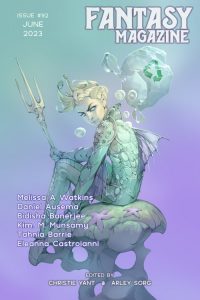Paul Di Filippo Reviews The City in the Middle of the Night by Charlie Jane Anders
 The City in the Middle of the Night, Charlie Jane Anders (Tor 978-0-7653-7996-2, $26.99, 368pp, hardcover, February 2019)
The City in the Middle of the Night, Charlie Jane Anders (Tor 978-0-7653-7996-2, $26.99, 368pp, hardcover, February 2019)
Charlie Jane Anders’s debut novel from 2016, All the Birds in the Sky, marked the emergence of a truly distinctive voice. In her tale of battling magicians and scientists, she managed to gainfully conflate a touching love story with a scary apocalypse, yoking the quotidian with the cosmic, the comic with the tragic. Full of witty dialogue and spot-on sociopolitical observations, moving from intimate detailed moments to grand sweeps of time, the book blended the streetwise mode of Lev Grossman and Cory Doctorow with the more fey and outré stylings of John Crowley and Liz Hand.
Anders could have repeated this accomplishment ad infinitum and found a welcome reception. But in her second novel she bravely and laudably chucks overboard nearly everything familiar from the first and dives into a kind of New Weird territory where she can employ different kinds of characters and narrative strategies and address different concerns. Her literary ancestors this time around emerge as Roger Zelazny, China Miéville, and those select writers who can take a cognitively estranged novum and flesh it out in believable colors and textures: Adam Roberts and Greg Egan, for example.
From the very inception of its title—which evokes that classic of dark romanticism, James Thomson’s epic poem The City of Dreadful Night—the reader senses that he or she is in for some kind of dark thrill ride. And Anders provides that in spades.
Our setting is the planet January, tidally locked so as to feature one hemisphere in permanent blazing sunlight, one in frozen darkness. Life—at least for the human colonists—is possible only in the small interstitial zone. But there, at least, no special apparatus is needed for survival. (Immediately, recalling the old paradigm of life on Mercury, we are in a kind of revisionist version of the fruitful Old Solar System continuity, the same “yesterday’s tomorrow” staked out recently in the Old Mars and Old Venus anthologies assembled by Gardner Dozois.)
Humans came here generations ago from a dying Earth, in a now-abandoned Mothership that still survives in decaying orbit. The first settlement to be created is the city of Xiosphant. But after the place ossifies into a kind of authoritarian hive of conformity—the city dictates even the rituals of sleeping and waking—dissenters break off to found the smaller city of Argelo. At the time of our tale, the two antithetical cities have little to do with each other, save for some minor trade conducted by such irregular groups as the Resourceful Couriers, those who brave the many dangers of the wild lands and seas between the two burgs.
The narrative chores will be divided in half. Our first viewpoint character is a young woman named Sophie, orphaned and poor. We encounter her in her student days, when she bonds with the rich and glamorous Bianca. But then, tragedy! Sophie falls afoul of the city’s rulers and is given the worst sentence: exile into darkness, or certain death. But after she is stranded in the deadly wilderness, Sophie is rescued by a giant native lifeform, a “crocodile.” She will become the first human to recognize that the crocodiles—the Gelets—are sentient, have a technology, live in their own hidden city, and are shapers of the planet’s actual ecology.
Restored to the city, Sophie must stay in hiding, and cannot risk contacting her beloved Bianca, who is busy planning an overthrow of the establishment.
Enter our second protagonist, another young woman named Mouth. Arriving in Xiosphant as one of the Resourceful Couriers, Mouth has been hardened into an expert in survival, a cynical mercenary of sorts, closed-off emotionally to everyone but her lover, Alyssa. But at the core of Mouth’s being is a hole: she was born into a tribe of nomads, the Citizens, and is the last of her kind. When she learns that the palace in Xiosphant holds the only copy of her tribe’s most sacred text, she throws in with Bianca, co-opting the revolution for her personal goals.
But things go pear-shaped. Bianca, Sophie, Mouth and Alyssa, with some others, must flee the city for Argelo. Their journey is fraught with many deadly incidents. Finally reaching safety, they settle into a new life. But Bianca’s plans to topple the government of her native city still smolder, and soon the second act of the rebellion is underway. There’s only one problem. Sophie and the Gelet have different goals than the humans, and together they are a faction to be reckoned with.
Anders has created a unified story that integrates any number of complex submechanisms into its organic and authentic whole. First comes the depiction of the planet and its contorted, oppositional societies. I think of what Adam Roberts did in his debut novel, Salt, and of course what Le Guin did with The Dispossessed. Different philosophies of living and governance are put into play against each other, and embodied in the various characters. But there’s also a Delanyesque strain of sensual life-as-she-is-lived, as found in a book like Triton, or in Sam Miller’s second-generation Blackfish City. And as alluded to earlier, Miéville’s Bas-Lag, with its many milieus, hovers like a beneficent patron spirit.
As she showed us in her first book, Anders is very focused on matters of the heart, and she doubles her scope here, giving us not one love affair—Bianca and Sophie—but a second: Mouth and Alyssa. The contrasting parameters of each union get a jolt when fate breaks up the pairings and reconfigures the lovers.
Anders’s concern with social structures, on display in her first book, also gets an even more sophisticated exegesis here. The book is full of aperçus and aphorisms (and enlivened scenes) that deliver her judgments on the folly and wisdom of mankind. “A lot of what people call civilization is just neglect.” “We’re doomed if these two cities don’t start working together…This is a harsh, ugly planet, and we need to pool our resources or we will all starve in our own filth.” Never didactic or preachy, Anders illustrates by action and characterization the various approaches to mutuality and consensus that underpin human life.
Exhibiting the strangeness of Ballard’s “Chronopolis” and Alec Proyas’s Dark City, along with the exoticism of Zelazny’s Jack of Shadows and the alien otherness of Silverberg’s Downward to the Earth, Anders’s sophomore outing proves that she can embrace passionately and creatively just about anything she turns her hand and mind to.
 While you are here, please take a moment to support Locus with a one-time or recurring donation. We rely on reader donations to keep the magazine and site going, and would like to keep the site paywall free, but WE NEED YOUR FINANCIAL SUPPORT to continue quality coverage of the science fiction and fantasy field.
While you are here, please take a moment to support Locus with a one-time or recurring donation. We rely on reader donations to keep the magazine and site going, and would like to keep the site paywall free, but WE NEED YOUR FINANCIAL SUPPORT to continue quality coverage of the science fiction and fantasy field.






